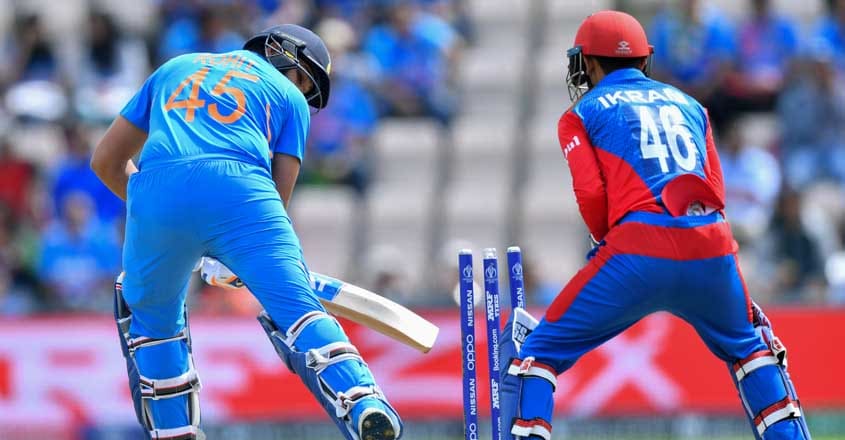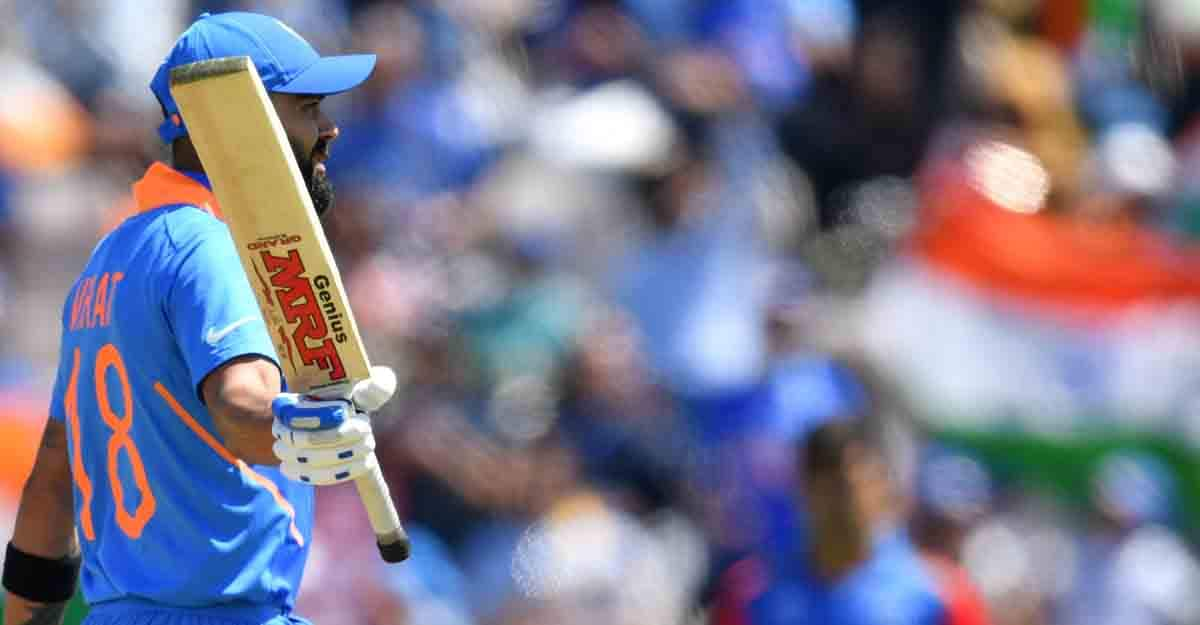A wake-up call for Team India

Mail This Article
The week that went by in the ICC World Cup finally produced the excitement and thrill that cricket is renowned for. The predictability that had been visible during the previous weeks was replaced by a newfound penchant from teams placed at the bottom of the table to spring surprises while taking on those at the top.
Table leaders New Zealand and India overcame stiff challenges from lowly Afghanistan and the mercurial West Indies respectively while hot favourites England were forced to bite the dust against a resurgent Sri Lanka. Bangladesh overcame the West Indies, comfortably chasing a target in excess of 300 runs, thus retaining an outside chance of advancing to the semifinals.
Shock win

The defeat suffered by England at the hands of Sri Lanka would rank as the first genuine upset in this edition of the championship. Despite their loss to Pakistan, the hosts had looked like a well organised and balanced side capable of going the whole distance. They may still make it to the knockout stage, but the propensity of the side for having frequent off days should worry the management of the team as well as its supporters.
New Zealand, on the other hand, survived a late onslaught by Carlos Brathwaite that brought the West Indies to within six runs of a victory. The excellent form of Kane Williamson, around whom the Kiwi batting revolves, and their pace bowlers ensured that the Black Caps have remained unconquered till date in the tournament.
Scare for India

India, who had hit a high after the 89-run win against Pakistan at Old Trafford, were expected to have it easy against Afghanistan when the two sides met at Southampton. The Afghans had lost all their five previous matches and, even worse, appeared to be coming apart as a team after the onslaught by the England batsmen. Rashid Khan, the spearhead of their attack, was taken to the cleaners, and question marks were posed about the ability of the leggie to make any impact on the tournament. Their batting, never a strong point given the poor infrastructure available for the game in that country, had not thrown up any surprises either. Pundits predicted that it would be a stroll in the park for Kohli’s men, with many even venturing to suggest that the team management should rest the regulars and give chances for those warming the benches in this outing.
What went wrong for India at Southampton? Was it mere complacency or a manifestation of any deeper malaise which had been hidden during the wins in the first three completed matches? What are the lessons that the side should take away from this scare? How is it that the side which outplayed Australia and Pakistan was made to sweat it out against Afghanistan? These questions would be bothering the followers of the game in the country and deserve a detailed analysis.

In the first place, India were guilty of being engulfed in a cloud of smugness, following their overwhelming win over Pakistan. This was reflected in their approach towards the game, reading of the pitch and, more importantly, in the selection of the playing eleven. It appeared that the team started believing that Afghanistan were pushovers. The team chose to bat first, under the impression that the wicket was full of runs and looked to post a total in excess of 350 runs. The pitch was a slow one, where ball did not come on to the bat and thus did not encourage flashy strokeplay. A total of 280 to 300 was the maximum possible score on this pitch, a fact that was missed by the Indian camp, which aimed higher and lost wickets in the process.
While batting on such tracks, it is imperative that a top order batsman drops anchor and guides the side to the targeted score. Rohit Sharma had performed this task admirably in the tie against South Africa. However, he perished early and though skipper Kohli played a polished innings of 67, he fell, while trying to force the pace when India were cruising. An analysis of the Indian innings would show that the top order, with the exception of Rohit, fell while trying to step up the scoring rate. Had the side aimed at a target score in the region of 270-280, these batsmen might have shown more patience and stuck around for longer, helping India to reach a higher total than what they finally managed. Thus India ended up with a total (224/8) which was at least 50 to 60 runs less than what the side was capable of.

Cautious approach
Kohli understandably preferred caution when it came to defending the low score and used only five bowlers. It is to the credit of bowlers that they performed the task entrusted to them with aplomb and provided the necessary breakthroughs at critical junctures, when the match appeared to be slipping out of India’s hands. They hardly bowled any loose deliveries and held their nerve during the last five overs when the game could have swung either way. However, if the end result was different, questions would certainly have been asked as to why the captain did not try out Vijay Shankar and Kedar Jadhav. Shankar had picked up two wickets against Pakistan, and conventional wisdom stated that a bowler like Jadhav, whose forte is unorthodox slow stuff, would have been effective on wickets like the one at Southampton. However, Kohli chose to ignore the bowling skills of these two completely on Saturday.
Shankar batted at No.4 where he gave good support to Kohli before being dismissed trying to play the sweep shot. As he was not called upon to bowl, it must be assumed that he was selected for this match solely as a batsman. This would beget the question as to whether he is a better batsman than Rishabh Pant who joined the squad in place of the injured Shikhar Dhawan. Both raw statistics as well as other performance indicators state that, as a batsman, Pant is streets ahead of Shankar. Further, Pant also brings with him the advantage of being a left-hander, which creates difficulties for the opposition bowlers. It could be the case that Kohli decided not to use the bowling skills of Shankar on account of the low total India were defending. However, in the final analysis, playing him purely as a batsman, while keeping Pant on the benches did not come across as a brilliant move.

Jasprit Bumrah was chosen as the man of the match for his brilliant bowling performance, which spared India's blushes. Afghanistan were cruising at 106/2 when Bumrah dismissed the well-set pair of Rahmat Shah and Hasmatullah Shahidi in the space of three balls to bring India back into the game. Then, when 21 runs were required off the last 12 balls, with three wickets remaining, Bumrah bowled a terrific penultimate over, conceding only five. This ensured that, with 16 still required, India were still in the game with more than a fighting chance when the last over started. Mohammed Shami came back strongly, after conceding boundary off the first ball of the last over to pick up the three remaining wickets and claim a hat-rick as well. But it was Bumrah’s brilliant final spell that ensured that pressure would be on Afghans at the death. A special mention must be made of Yuzvendra Chahal, who kept his cool after being reverse swept by Rashid in the 46th over and had the batsman stumped soon by luring him forward with a perfect leg break.
Another positive was that Indian fielders did not wilt under pressure and held all the catches that were offered. Ground fielding was tight and no easy runs were gifted to the opponents. M S Dhoni was brilliant behind the stumps, besides chipping in nuggets of advice for the captain and the bowlers. The entire team moved like a well oiled machine while on the field and their actions bore the hallmark of an energetic and confident side bonded together by the glue of team spirit.

The scare from Afghanistan should be considered as a wake-up call for the Indian team to be better prepared for the sterner battles ahead. The team management should learn the lessons from this great escape and ensure that the mistakes committed against the Afghans are not repeated again. Similarly the followers of the game and supporters of the national side would do well to remember that Pakistan is only one of the 10 sides taking part in this tournament and victory over them would not be a substitute for winning the championship.
Kohli's men posses the potential and prowess to win the World Cup. All they need to do is to play to the best of their ability without allowing distractions or complacency to deter them from their objective.
(The author is a former international umpire and a senior bureaucrat)


